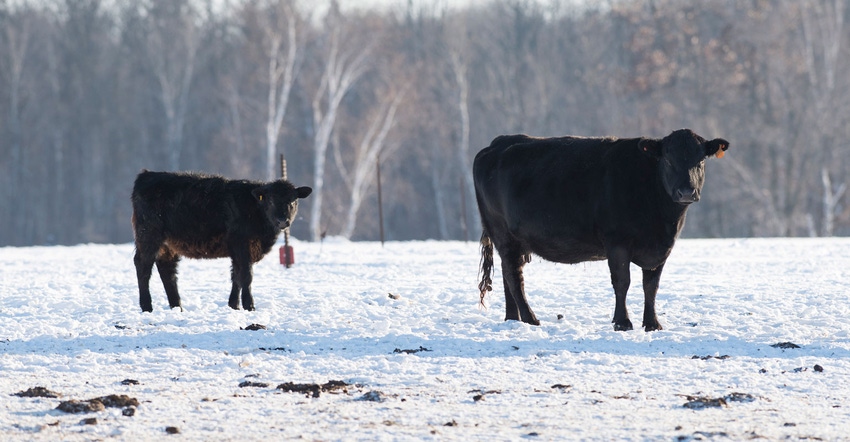November 25, 2020

In Wisconsin, winter is a fact of life in which severe cold temperatures and windchills, and blowing and drifting snow are common occurrences. Cattle can adapt to cold temperatures and maintain body condition if provided the appropriate nutrition and environmental protections. Here’s a look at some of the management practices you can have in place to ensure your herd thrives this winter.
Wind protection
As a producer, you can diminish winter conditions to some extent with proper planning and facility design, and good management practices. A significant first step is to have in place a form of wind protection. Cattle need protection from the wind, especially during periods of bitterly cold temperatures and severe windchills. Wind will increase the harmful effects of already cold days, which can be exaggerated even more when bedding conditions are wet, and an animal’s natural insulation provided by its hair coat is compromised.
Wind protection can be provided by constructing wind fences, planting shelterbelts or combining the two. A study by Anderson, V. L. and J. Byrd shows that multiple tree rows of varying heights and maturities planted 50 to 100 feet upwind from the wintering pens will slow the wind and allow drifting snow to drop among the trees, thereby reducing the amount of snow deposited in the pens.
Constructed wind fences can be permanent or portable structures built in the fence line or placed inside the enclosures for all-around protection. Constructed wind fences that are 20% open and 80% solid allow some air to pass through and reduce downwind velocity a distance of 10 to 30 times the wind fence’s height. This means that a 10-foot wind fence may reduce wind velocity effectively from 100 to 300 feet downwind, depending on wind speed and direction. Porous wind fences also spread out snow accumulation.
Solid fences cause swirling and heavy snow accumulation immediately downwind and create smaller protected areas. An option for temporary wind protection can include piling bales of carryover hay, straw or cornstalks along the windward fence lines.
Dry bedding
As mentioned earlier, when an animal’s hair coat becomes wet, its natural ability to insulate against cold weather becomes compromised. In the spring, wet and muddy conditions can contaminate udders, leading to health challenges in newborn calves. A way to prevent these complications is to provide adequate dry bedding and to perform regular pen maintenance. Bedding helps moderate the cold by keeping cattle clean and providing insulation from the snow and the frozen ground.
Pen maintenance is essential as ice and packed snow buildup may cause slick and hazardous footing, especially behind fence-line bunks and around water fountains. Removing ice and snow buildup provides a better base for the cattle and helps avoid slips and falls that can lead to abortions or injury to bones and joints. Water fountains or tanks should be checked daily during severe cold to ensure the waterers are operational.
As a beef producer, you can take some easy steps to help ensure your cattle thrive through the winter by thinking through the protections you provide for them. Modifying the environment with wind protection and proper bedding are good husbandry practices that will reduce your herd’s maintenance needs and health complications. Additionally, following up with pen maintenance to ensure sound footing for your animals will limit leg and joint problems.
Young is the Extension agriculture educator in Dodge County, Wis. This column is provided by the University of Wisconsin-Extension’s Wisconsin Beef Information Center.
You May Also Like




